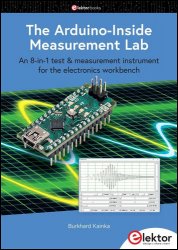 Название: The Arduino-Inside Measurement Lab : An 8-In-1 Test and Measurement Instrument for the Electronics Workbench
Название: The Arduino-Inside Measurement Lab : An 8-In-1 Test and Measurement Instrument for the Electronics WorkbenchАвтор: Burkhard Kainka
Издательство: Elektor
Год: 2024
Страниц: 130
Язык: английский
Формат: pdf (true)
Размер: 32.2 MB
A well-equipped electronics lab is crammed with power supplies, measuring devices, test equipment and signal generators. Wouldn't it be better to have one compact device for almost all tasks? Based on the Arduino, a PC interface is to be developed that's as versatile as possible for measurement and control. It simply hangs on a USB cable and — depending on the software — forms the measuring head of a digital voltmeter or PC oscilloscope, a signal generator, an adjustable voltage source, a frequency counter, an ohmmeter, a capacitance meter, a characteristic curve recorder, and much more. The circuits and methods collected here are not only relevant for exactly these tasks in the "MSR" electronics lab, but many details can also be used within completely different contexts.
In addition, there are tools, components and the many assemblies and projects you’re working on. It can get crowded in the lab. Wouldn’t it be better to have one compact device for almost all tasks? All in one, small and versatile, as well as inexpensive and easy to procure. After several attempts with other systems, the choice fell on the Arduino Nano. On this basis, a PC interface as versatile as possible for measurement and control is to be developed.
The first tests have shown that Arduino sketches are not really real-time capable. Things run in the background that you can’t see. Many time-critical tasks cannot be solved this way. One way out is that the IDE can also compile pure C code, because the GCC compiler is used in the background. Usually every sketch contains a function void setup() and a function void loop(). If you delete these two, everything stays clean. Instead a function int main(void)is needed.
Скачать The Arduino-Inside Measurement Lab : An 8-In-1 Test and Measurement Instrument for the Electronics Workbench